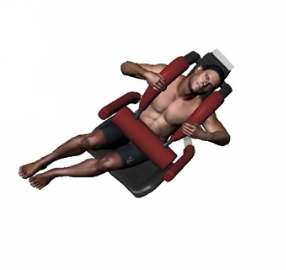Markets
The Underlying Model
- Biomechanics
- Physiological modeling
- Strength & Fatigue
- Artificial intelligence
- Predicts behavior
- Physics-based
Market
Human Systems Integration
Human Performance and readiness
PPE, Armor, and Survivability
Santos The Ultimate Test Dummy for Personal Protective Equipment (PPE)
Santos, the biomechanically-accurate virtual soldier developed at the University of Iowa, transcends his military origins to become an invaluable tool for assessing personal protective equipment (PPE), particularly armor. Here’s how Santos can revolutionize the evaluation process:

Hit Detection and Ballistics Evaluation
Internal Organ Protection
Inertia and Task- Based Performance
Weight Distribution and Center of Gravity (CG)
Range of Motion and Restriction
Mobility, Agility, and Balance
Torque and Leverage
Sizing and Fit (Beyond Basic Sizing)
Bulk and Workspace Considerations
Head Protection (Helmet):
Product Design, and Testing
Product Design, Development and Testing
Santos: The Digital Test Subject for Product Design, Development, and Testing
Santos, iHuman’s biomechanically-accurate human digital twin, transcends his military applications to become a powerful human digital twin for product design, development, and testing. Here’s how Santos can revolutionize these processes:
Assessing Usability:
Hand Grasping and Fine Motor Skills
Fit and Function
Reach and Vision
Vision and Sensory Inputs
Force and Torque Requirements
Anthropometry and User Diversity
The PPE a and armor nalysis can support the following:
Design Capabilities: Develop a method for designing flexible armor, including size, weight, and bulk, ensuring adaptability to diverse mission requirements.
Mobility Enhancement: Specify flexible joints and define a range of flexibility to enhance Soldier mobility, considering the wide range of movements required in combat scenarios.
Anthropometric Variability: Incorporate the ANSUR database to vary anthropometry, reflecting diverse body types within the US Army, ensuring that armor designs cater to the entire spectrum of Soldier body types.
Realistic Scenarios: Integrate methods for varying Soldier weight and strength to simulate real-world scenarios, allowing for a comprehensive assessment of armor performance in dynamic conditions.
Loading Simulations: Implement a system for loading armor onto the body at specified locations, considering the ergonomic and functional aspects of the gear placement.
Task Customization: Allow the selection of specific tasks, gear, and loading conditions for Soldiers, including five distinct tasks, ensuring that the iArmor system covers a broad spectrum of combat scenarios.
Statistical Analysis: Output statistically analyzed results to assess mobility, maneuverability, and overall Soldier performance, providing quantitative metrics for evaluating different armor configurations.

Human Systems Integration
- Predicts behavior
- Habitability
- Human Factors

Human Factors Engineering
- Reach
- Vision
- Accessibility
- Workspace modeling
- Efficiency
- Systems Safety
- Fit
- Form
- Force/Torque
- Human performance

Human Factors Engineering Systems Safety
- Reach
- Human Force Requirements
- Human Torque Requirements
- Vision
- Accessibility

Human Performance
- Video Ingress-Egress

Human Systems Integration
- Workstation Design & Analysis
- Human Vibration
- Human Factors Engineering
- Cab design
- Controls analysis

Product Design, Development and Testing
- Human Safety
- Accommodation
- Human Factors Engineering
- Human performance
Soldier is subjected to motion dynamics, perform analysis, understand the cause and effect.

Human Performance
- Accommodation
- Excessive Vibration
- Comfort
- Space analysis
- Systems Safety

